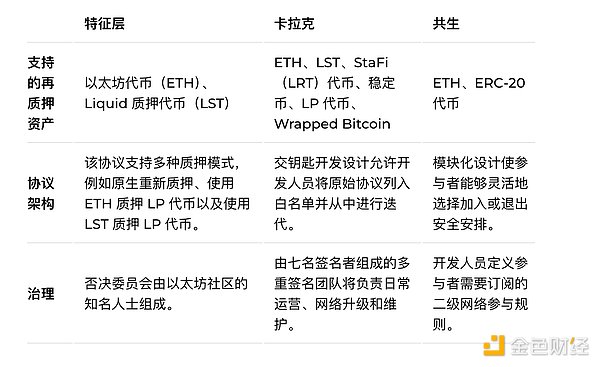Source: unchainedcrypto Translation: Shan Ouba, Golden Finance
The EigenLayer protocol is popular for being the first to re-stake Ethereum tokens. However, the protocol's recent decision to ban US and Canadian users from participating in the upcoming EIGEN token airdrop has put other staking protocols such as Karak and Symbiotic in the spotlight.
But how do Symbiotic and Karak differ from EigenLayer?
In this guide, we will look at emerging proof-of-stake protocols Symbiotic and Karak, how they differ from the EigenLayer protocol, and how they differ from each other.
What is re-staking?
Re-staking refers to further staking of staked assets or liquid staked assets to protect other networks or applications.
The concept aims to repurpose idle assets to pay for the startup costs of new protocols and in the process incentivize re-staking via re-staking rewards.
What is EigenLayer and what role does it play in the Ethereum re-staking ecosystem?
EigenLayer facilitates the re-staking of staked ETH and allows stakers to earn additional re-staking rewards for their contributions.
The protocol leverages re-staking to export Ethereum’s trust infrastructure to new protocols that lack sufficient resources to incentivize new validators.
That being said, EigenLayer is currently focused on re-staking ETH assets and Lido’s Liquid Staking Token (LST), with plans to expand the network’s coverage in the future.
This initial scope creates opportunities for its two emerging competitors, Symbiotic and Karak.
What is Symbiotic?
Symbiotic is a new player in the restaking space, a permissionless protocol that allows validators to restake their own assets for shared security.
Symbiotic is modular in design, supports restaking of various ERC-20 tokens (including stETH), and gives developers full control over the entire restaking process. The protocol's minimal coordination layer can be plugged into existing or new protocols. In addition, its flexible restaking logic allows developers to choose their preferred collateral assets, validator nodes, rewards, and slashing systems.
Key Features of Symbiotic
Here are the main components of the Symbiotic protocol:
Multi-Asset Collateralization: Symbiotic supports re-collateralization from multiple networks, including ERC-20 compatible assets, LP tokens, and other digital assets.
Vaults: These are custom contracts that handle the delegation of collateral to operators across networks.
Operators: These are entities that manage infrastructure on behalf of a network.
Resolvers: Multi-purpose contracts responsible for approving or rejecting slashing penalties incurred by operators on the networks they provide services.
Network: These protocols require a set of validating nodes to provide a trusted minimal service.
Symbiotic Pros and Cons
Here are the pros and cons of Symbiotic:
Pros:
Provides flexibility to developers to customize the re-staking protocol to their needs: The network is responsible for the implementation of re-staking, and re-stakeholders can choose to join or leave the shared security contract.
Provide security at an affordable cost: By leveraging the collateralization of multiple assets to provide high-quality security, this not only makes it affordable to share the security cost of a new blockchain network, but also eliminates the complexity of building a security protocol from scratch.
Improved capital efficiency: Symbiotic’s permissionless network provides a scalable way for crypto re-staking holders to fund the startup costs of new projects.
Disadvantages:
What is Karak?
Karak is another new entrant into the re-staking space, differentiating itself from EigenLayer and Symbiotic by offering a more comprehensive approach to shared security.
The protocol supports a variety of assets, such as EigenLayer core products such as ETH and LST, but further adds LP tokens, stablecoins, WBTC, StaFi's Liquid Equity Token (LRT), etc.
Karak allows stakers to re-stake their staked tokens and submit their assets to the Distributed Security Service (DSS) on the Karak protocol, granting them additional execution rights on their staked assets.
Key Features of Karak
The key features of the Karak protocol are as follows:
Re-stakers: These participants protect Ethereum and other networks in exchange for rewards.
Distributed Security Service: DSS leverages re-pledged assets to improve security while reducing operational costs.
Chain: A chain or aggregation uses the services provided by a distributed security service.
Operator: Can be an individual or entity that verifies a distributed security service.
Karak Pros and Cons
Karak’s pros and cons are as follows:
Pros:
Multi-asset re-pledge: This component enables re-pledgers to provide a basket of assets to the DSS, preventing the failure of a single asset from jeopardizing the DDS.
Unlimited re-pledge: The protocol allows developers to build products on L2 and sidechains instead of focusing on Ethereum L1.
Turnkey Development: Karak’s powerful protocol allows developers to seamlessly iterate and deploy new unique services.
Disadvantages:
EigenLayer vs. Karak vs. Symbiotic Comparison
Here is a comparison of the three re-staking protocols:

Symbiotic and Karak offer two compelling approaches to changing re-staking as we know it today. EigenLayer focuses on Ethereum's core infrastructure, providing a strong and solid foundation for building secure decentralized applications.
But this only scratches the surface of the possibilities.
Symbiotic is emerging as a leader in enabling networks to derive economic security from a wide range of collateral assets. Its scalable network enables other networks to customize their re-hypothecation implementations.
Karak opens up new possibilities for interoperability and capital efficiency across multiple ecosystems through its wide range of supported assets. The protocol may introduce a two-sided staking approach in the future, incentivizing both users and service providers to actively participate in the network.
Conclusion
As Symbiotic and Karak continue to contribute to the re-hypothecation space, network builders and users will gradually realize their respective capabilities and limitations. By increasing the utility and security of collateral assets, these protocols are expected to drive further innovation in the Ethereum ecosystem.
 JinseFinance
JinseFinance





